A Roman legion was the largest military unit of the Roman army.
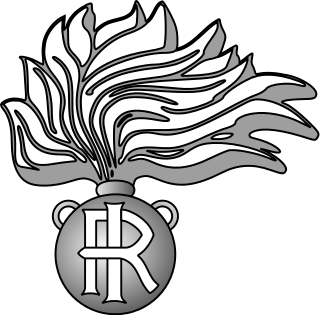
The Carabinieri are the national gendarmerie of Italy who primarily carry out domestic policing duties. It is one of Italy's main law enforcement agencies, alongside the Polizia di Stato and the Guardia di Finanza. As with the Guardia di Finanza but in contrast to the Polizia di Stato, the Carabinieri are a military force. As the fourth branch of the Italian Armed Forces, they come under the authority of the Ministry of Defence; for activities related to inland public order and security, they functionally depend on the Ministry of the Interior. In practice, there is a significant overlap between the jurisdiction of the Polizia di Stato and Carabinieri, who are contacted on separate emergency telephone numbers. Unlike the Polizia di Stato, the Carabinieri have responsibility for policing the military, and a number of members regularly participate in military missions abroad.

Demography is the statistical study of populations, especially human beings.

The Praetorian Guard was an elite unit of the Imperial Roman army whose members served as personal bodyguards and intelligence for Roman emperors. During the era of the Roman Republic, the Praetorians served as a small escort force for high-ranking officials such as senators or provincial governors like procurators, and also serving as bodyguards for high-ranking officers within the Roman legions. With the republic's transition into the Roman Empire, however, the first emperor, Augustus, founded the Guard as his personal security detail. Although they continued to serve in this capacity for roughly three centuries, the Guard became notable for its intrigue and interference in Roman politics, to the point of overthrowing emperors and proclaiming their successors. In 312, the Guard was disbanded by Constantine the Great, as he oversaw the destruction of their barracks at the Castra Praetoria.

A cohort was a standard tactical military unit of a Roman legion, though the standard changed with time and situation, and was composed of 480 soldiers. A cohort is considered to be the equivalent of a modern military battalion. The cohort replaced the maniple following the reforms attributed to Gaius Marius in 107 BC. Shortly after the military reforms of Marius, and until the middle of the third century AD, 10 cohorts made up a Roman legion. The cohorts were named "first cohort", "second cohort" etc. The first cohort gathered the most experienced legionaries, while the legionaries in the tenth cohort were the least experienced.
A cohort study is a particular form of longitudinal study that samples a cohort, performing a cross-section at intervals through time. It is a type of panel study where the individuals in the panel share a common characteristic.
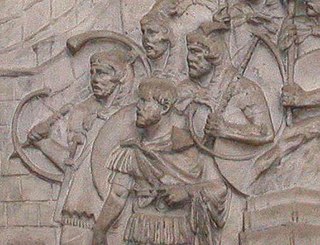
The Roman army was the terrestrial armed forces deployed by the Romans throughout the duration of Ancient Rome, from the Roman Kingdom to the Roman Republic and the Roman Empire, and its medieval continuation, the Eastern Roman Empire. It is thus a term that may span approximately 2,206 years, during which the Roman armed forces underwent numerous permutations in composition, organisation, equipment and tactics, while conserving a core of lasting traditions.
The Vigiles or more properly the Vigiles Urbani or Cohortes Vigilum were the firefighters and police of Ancient Rome.

A centurion was a professional officer of the Roman army after the Marian reforms of 107 BC. Centurions commanded a century of around 80 legionaries. The centuries commanded by the centurion theoretically derive from centum ("hundred"), but that connection is now disputed. It certainly meant "company" or "tribe", but senior centurions commanded cohorts or took senior staff roles in their legion. Centurions were also found in the Roman navy. In the Byzantine Army, they were also known by the name kentarch. Their symbol of office was the vine staff, with which they disciplined even Roman citizens protected from other forms of beating by the Porcian Laws.
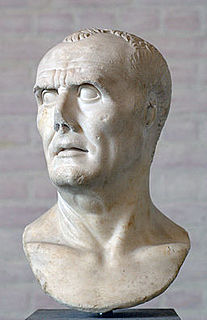
The Marian reforms were reforms of the ancient Roman army implemented in 107 BC by the statesman Gaius Marius, for whom they were later named. The reforms originated as a reaction to the military and logistical stagnation of the Roman Republic in the late 2nd century BC. Centuries of exponential military campaigning throughout the Mediterranean and increasing invasions and uprisings across Roman territory had stretched the human and physical resources of the Roman army. The 'maniple' militia used since the Samnite Wars (343-290BC) emerged as inadequate for the demands of the expanding Roman territory.
The cohortes urbanae of ancient Rome were created by Augustus to counterbalance the enormous power of the Praetorian Guard in the city of Rome and serve as a police force. They were commanded by the urban prefect.
The term ethnotaxonomy refers either to that subdiscipline within ethnology which studies the taxonomic systems defined and used by individual ethnic groups, or to the operative individual taxonomy itself, which is the object of the ethnologist's immediate study.
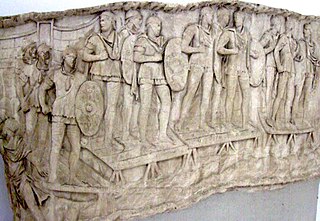
The Auxilia were introduced as non-citizen troops attached to the citizen legions by Augustus after his reorganisation of the Imperial Roman army from 30 BC. By the 2nd century, the Auxilia contained the same number of infantry as the legions and, in addition, provided almost all of the Roman army's cavalry and more specialised troops. The auxilia thus represented three-fifths of Rome's regular land forces at that time. Like their legionary counterparts, auxiliary recruits were mostly volunteers, not conscripts.
The structural history of the Roman military concerns the major transformations in the organization and constitution of ancient Rome's armed forces, "the most effective and long-lived military institution known to history." From its origins around 800 BC to its final dissolution in AD 476 with the demise of the Western Roman Empire, Rome's military organization underwent substantial structural change. At the highest level of structure, the forces were split into the Roman army and the Roman navy, although these two branches were less distinct than in many modern national defense forces. Within the top levels of both army and navy, structural changes occurred as a result of both positive military reform and organic structural evolution. These changes can be divided into four distinct phases.

In Ancient Rome, the vicus was a neighbourhood or settlement. During the Republican era, the four regiones of the city of Rome were subdivided into vici. In the 1st century BC, Augustus reorganized the city for administrative purposes into 14 regions, comprising 265 vici. Each vicus had its own board of officials who oversaw local matters. These administrative divisions are recorded as still in effect at least until the mid-4th century.
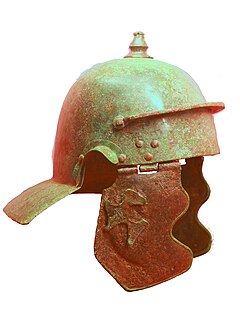
The Alpine regiments of the Roman army were those auxiliary units of the army that were originally raised in the Alpine provinces of the Roman Empire: Tres Alpes, Raetia and Noricum. All these regions were inhabited by predominantly Celtic-speaking tribes. They were annexed, or at least occupied, by the emperor Augustus' forces during the period 25–14 BC. The term "Alpine" is used geographically in this context and does not necessarily imply that the regiments in question were specialised in mountain warfare. However, in the Julio-Claudian period, when the regiments were still largely composed of Alpine recruits, it is likely that they were especially adept at mountain operations.
The Imperial Roman army was the terrestrial armed forces deployed by the Roman Empire from about 30 BC to 476 AD, the final period in the long history of the Roman army. This period is sometimes split into the Principate and Dominate (285–476) periods.
Roman infantry tactics refers to the theoretical and historical deployment, formation, and manoeuvres of the Roman infantry from the start of the Roman Republic to the fall of the Western Roman Empire.

Pax Romana is a Classical reenactment society based in the Netherlands, with the main goal to show Romans in the Netherlands as they would have lived in the last quarter of the first century AD.









